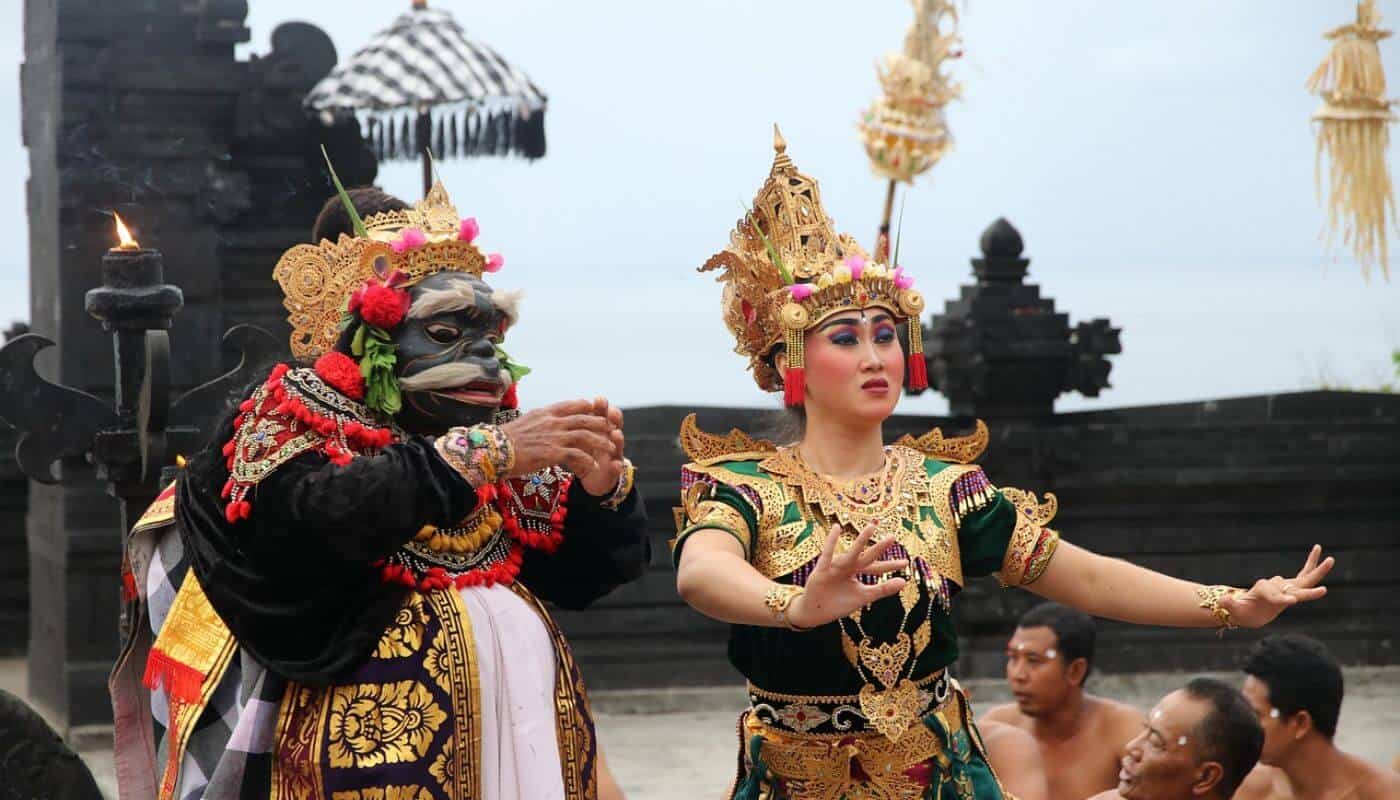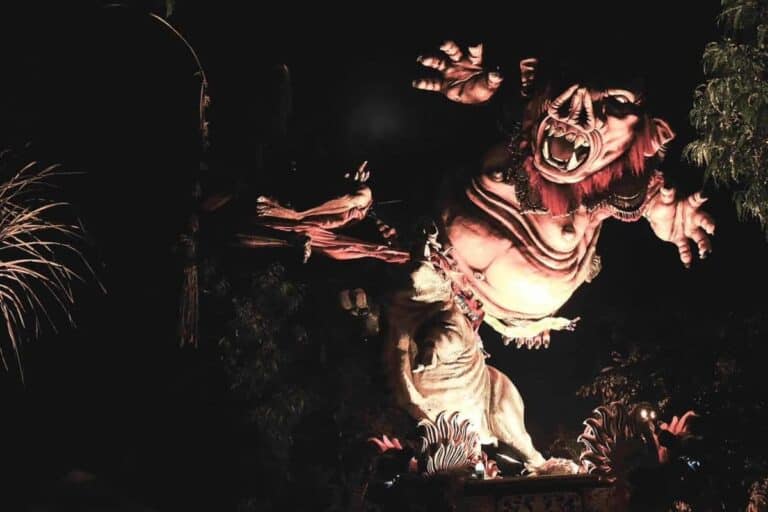There’s no music, only dozens of shirtless men wearing cloth pants, sat in a circle, chanting ‘Cak cak cak’, swaying and playing with fire.
A Kecak dance performance in Bali is mesmerizing, and one of the experiences you don’t want to miss on your visit to the island of the Gods.
Kecak dance is a performance of the love story of Rama and Sita, from the legends of Ramayana.
It tells the story of Rama’s struggle with Hanoman, the white monkey, rescuing Shinta who was kidnapped by Ravana, and of Shinta’s loyalty by self-immolation for Rama.
The History of Balinese Kecak Dance

The Kecak dance is believed to have been created by a Balinese dancer named Wayan Limbak, and a German painter named Walter Spies in 1930.
The dance is inspired by the Sanghyang tradition, where the dancers are possessed by spirits who interact with the ancestors or gods. The dancer is used as a medium to convey His word.
When possessed, they can perform extreme actions like walking on fire, or making sounds that are not human.
In the dance, there are usually several chapters of the legendary story of the Ramayana, where Rama tries to save Shinta from the evil hands of Ravana.
During his efforts, Rama is assisted by a white monkey who has a funny and tickling temperament. Usually a white ape, this Hanoman teases the audience, acting as a joker.
Kecak dance is often performed at religious ceremonies. Now a magnet for tourists, you fill find larger performances available daily across the island.
What Happens at a Kecak Dance?

The traditional Kecak dance is usually performed by 50-60 shirtless male dancers. They sit in a circle, with several fire torches in the middle.
Wearing Balinese checkered sarongs (kain poleng), the dancers will shout “cak” while raising their hands.
It is incredibly unique as there is no accompanying music or stage set. All of the sounds are produced from the dancers.
The dancers focus on shouting “cak”, their voices like a chorus that creates an energetic atmosphere.
The swaying movements create a dynamic, energetic, and upbeat rhythm, sending chills down your spine.
The tempo of the show feels like it is increasing, making an even more magnetic and interesting performance.
The Kecak dance is generally performed in an open space, at sunset.
Where to Watch Kecak Dance in Bali

Kecak dance performances can be found all over Bali, from the middle of the tourist area to the edge of the cliff.
Here are some of the most popular spots to watch Bali’s Kecak dance.
Uluwatu Temple
Imagine flames, combined with the rhythmic shouts of ‘cak cak cak’, married with a view of the sunset and the ocean. Uluwatu Temple is one of the most beautiful places to see the Kecak dance.
GWK Cultural Park
Not only home to one of the tallest statues in the world, at GWK Cultural Park you can enjoy a Kecak dance performance featuring Ogoh-ogoh – giant statues that represents the mythical creature Garuda.
Kecak Garuda Wishnu Kencana is performed every day at Lotus Pond at 6pm.
Pura Dalem Taman Kaja
Famous for its calm environment, Ubud is one of the most well-known places to watch the Kecak dance, at Pura Dalem Taman Kaja.
Every Wednesday and Saturday, starting at 7pm, you can watch the intense performance as the sun sets overhead.
Pura Dalem Ubud
Pura Dalem Ubud has a different atmosphere compared to other temples in Bali.
Known as the temple of death, it is dedicated to Rangda, the Demon Queen.
The Kecak dance show runs every Monday to Friday.
Other Traditional Balinese Dances

Dancing is a popular form of storytelling in Bali. Kecak dance is the most famous, but there a few others worth knowing!
Legong Dance
Legong dance was created based on a dream had by a King in Sukawati. He saw angels dancing in heaven, wearing headdresses made of gold.
The dance represents the Balinese people’s gratitude to the ancestors for abundant blessings.
Traditionally, Legong dance can only be performed by female dancers who have not reached puberty. When they are married, they must stop performing.
However in the modern world, you will see older dancers, perhaps even men!
Barong and Keris Dance
The Barong and Keris dance depicts the battle between Good, symbolized by the mythological Barong, against Evil represented by Rangda, who is all-powerful.
It is an entertaining dance as the storyline is interesting and funny.
Janger Dance
Initially, the Janger Dance was a form of singing by the farmers.
Now, the Janger Dance performance is played by female dancers (called Jangger) and male dancers (called Kecak) with elements of pencak silat, a traditional martial art, in a sitting position.
The dance moves are in line with the vocals that are sung at a passionate tempo.
Final Thoughts
Every trip to Bali needs a trickle of culture.
Watching a Kecak dance and getting immersed in the intense performance is a great way to witness the beauty of Balinese culture.
Be ready for the show of a lifetime in a stunning, tropical setting!
Featured image: Kecak Dance Uluwatu




